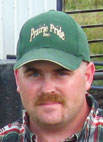
Input costs keep going up. The three big “F” words (feed, fuel, fertilizer) are still on everybody’s lips. But what if there was a way to reduce those costs and bring a premium price for your product to boot?
Coscia Limousin Manager Ben Bennett is on to something.
Bennett manages more than 500 acres owned by surgeon Robert Coscia. Coscia has owned the farm for about 30 years and started raising cattle for his kids to show. They grew up, his surgical practice grew and he took on a farm manager and moved to Idaho.
According to Ben, “At one time Dr. Coscia had one of the best herds in the U.S. In the mid 90s he was also President of NALF (North American Limousin Foundation).”
Ben started running the place five and a half years ago. It is made up of two operations; 223 acres just east of Springfield, Mo., in Greene County, where the registered Limousin are kept, and another 280 acres in Fordland, Mo., which is mainly a commercial herd.
For most of his time as manager, Bennett has been marketing in a variety of traditional ways: selling bulls to commercial breeders, sales at the Springfield Livestock Market and the Polled Positive sale in Strafford, Mo., and through private treaties.
Earlier this year a sort of partnership was announced that provides Limousin producers access to a new and potentially lucrative market.
The New Grey Meat
Veal is typically from young dairy calves but in more recent years has garnered some negative publicity for the way some producers raise these calves.
“High society don’t like calves raised in a crate,” remarked Ben.
Strauss Veal and Lamb in Wisconsin have a product they call Meadow Reserve veal. They’ve done extensive testing on various breeds and determined that Limousin provided the best cut for the type of veal they (and their customers) desired.
“I had some calves set up for Strauss this fall but the grass was too good and they got too big,” noted Ben.
In addition to requiring producers to avoid antibiotics, keep their calves on pasture, use no hormones or animal by-products – including milk-replacer, there are specific weight requirements.
Ben continued, “They want calves to weigh between 450-500 pounds and if you hit their targets, you get a bonus. Plus getting calves off the cow a month early gives more recovery time before the next calving.”
Strauss also accepts bulls so no castrating is needed, horns are okay and they will even come to the farm to pick up a pot-load (at least 90-100 calves) at no charge to the producer.
A Muscular Breed
Even without newer marketing opportunities, Limousins offer commercial producers an animal that is easy calving and one that puts on weight better and faster.
“I don’t think you can put a better bull on a set of commercial cows. There is a craze that everything has got to be black, but in the end what makes you money is pounds. Muscle weighs more than fat and there isn’t nothing that puts more muscle on that calf like a Limi. Let’s say you got a 500 lb. calf and a 600 lb. calf. You might get 6 cents more per pound for that black calf but that extra 100 lbs will make you more money,” he said.
Ben relates three challenges to running an operation like Coscia:
“This is an urban farm. We’ve got some very close neighbors and that brings some challenges.” Coscia is adjacent to an upscale housing development.
“Marketing is always the biggest challenge for any seedstock producer.”
But to Bennett another and perhaps more important challenge is dealing with people.
“It doesn’t matter how good your cows or bulls are, if people don’t like you they won’t deal with you. You’ve got to enjoy people and listen to your customers.”







